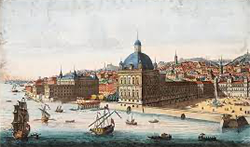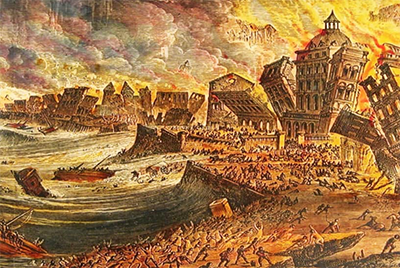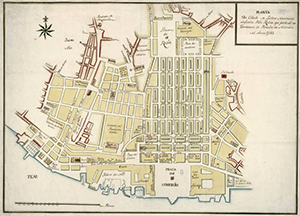The 1755 Lisbon Earthquake
On Nov. 1, 1755, a powerful earthquake shook the foundations of Lisbon and the faith of millions of Portuguese people. 
The population of Lisbon, the Portuguese capital, at that time was between 275,000 and 300,000 people. A great many of those people would have been attending church services when the earth shook. The date on the calendar was a holy feast day, the Day of All Saints, a special day in the Christian faith; as a result, a great many people in Lisbon and elsewhere were in church that day. The quake struck at 9:20 a.m. and lasted for three-and-one-half minutes. Estimates are that the intensity was at least 8.5 on the Richter Scale. (The length of the quake and the number on the Richter Scale vary by source.) Cracks up to 20 feet wide opened in the ground; into these newly created death traps fell people and buildings. Many churches had candles burning during the services. The building floors and walls rumbled, dislodging many lit candles, which, falling to the floor, set alight flowers, tapestries, and other flammable elements. Fires raged throughout the city for five days. 
In response to so many buildings shaking and crumbling, a great many people raced to the shoreline, unaware that the earthquake, which had its epicenter in the Atlantic Ocean 320 kilometers (199 miles) southwest of the city, had triggered a tsunami. The giant wave killed another large part of the population. In preparation for the influx, the sea receded significantly, revealing a number of shipwrecks and tempting artifacts, to which many people ran in order to gather up riches. Soon enough, the sea reversed course. Waves up to 9 meters (30 feet) high enveloped the city and its inhabitants. Another pair of tsunami hit within a few hours. Death tolls commonly stretch into the tens of thousands, with some sources saying that the overall number of people killed by the combination of disasters exceeded 100,000. The seawater was not enough to put out all of the flames. Fires raged for days. Within a week nearly 90 percent of Lisbon's buildings had been demolished by the earthquake, fires, or waves–or a combination of the three. Gone was Ribeira Palace, the royal residence; gone were the famed Se Cathedral and the Igreja do Carmo; also gone was the royal library and its 70,000 volumes. In a quirk of geography, the Alfama district, then home to some of the city's poorest residents, emerged largely intact because of the bedrock underneath a hill that was high enough to withstand tsunami pressure. King Joseph I had been in a church service earlier in the day but was near the coast when the first disaster struck. The royal family still felt the shaking, however, and the king developed an intense fear of enclosed places, so much so that the royal court became a series of large tents in the suburb of Ajuda. The head of government, Prime Minister Sebastião Melo (much more well-known as the Marquis of Pombal) directed the rebuilding. He also ordered soldiers to load a great many of the dead onto ships and send them out to sea, where they were burned; doing so likely prevented an outbreak of disease. In addition, the king and the prime minister set up gallows in plain sight around what remained of the city, to act as a deterrent against looting. Lisbon was by no means the only settlement devastated by the trifecta of disasters. Much of the Algarve lay in ruins. As many as 10,000 people along the coast of Morocco, in North Africa, died as well. Reports of damage came in from as far north as Finland. People living far across the Atlantic, in Brazil and in the Caribbean, reported widespread damage. Pombal and others learned their lesson from the massive shaking of the quake. New buildings were built to withstand future shakes. In some cases, members of the army helped simulate another earthquake by marching up and down the streets in large numbers. 
One benefit of rebuilding from brand new was that the redesign incorporated a regular layout, doing away with the collection of jumbled streets that reflected a city that had grown in many directions during a great many decades. Another result of the large-scale disaster was a change in thinking for many people about the cause of such events. Many people still thought of the devastation in terms of punishment from a deity. However, many people, driven by the burgeoning Enlightenment and Scientific Revolution, also thought in real-world terms, reasoning that the earthquake was a natural disaster, one caused by the normal occurrence of seismic forces. As well, Pombal sent scientists and others to gather testimony from eyewitnesses and survey the damage firsthand.
|
|
Social Studies for Kids
copyright 2002–2026
David White




